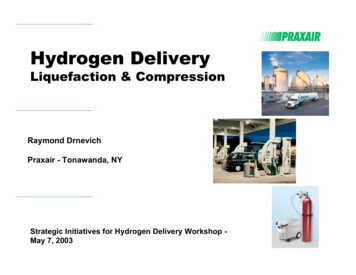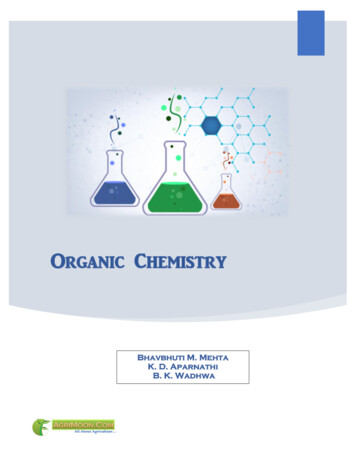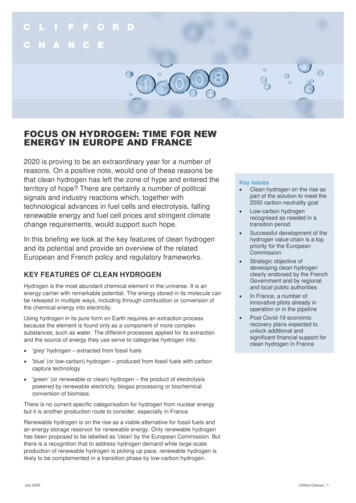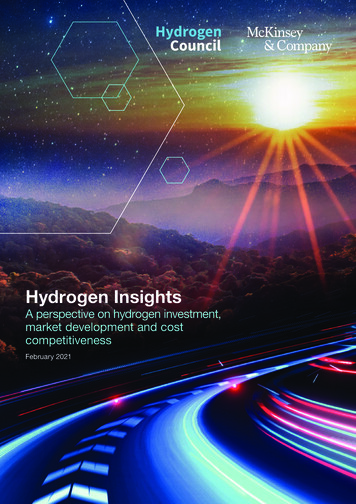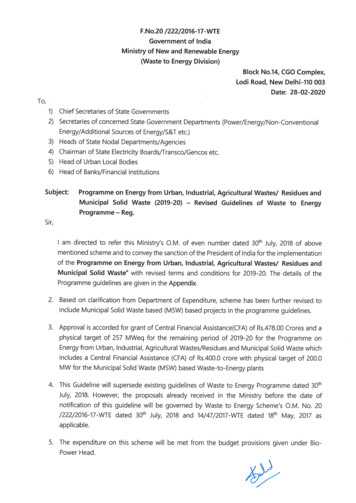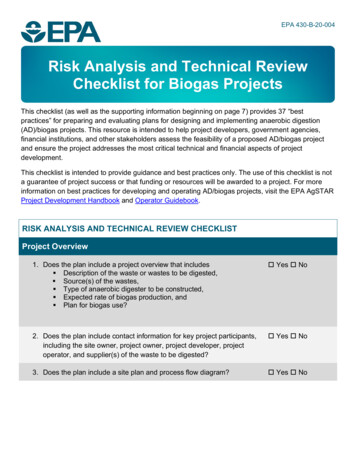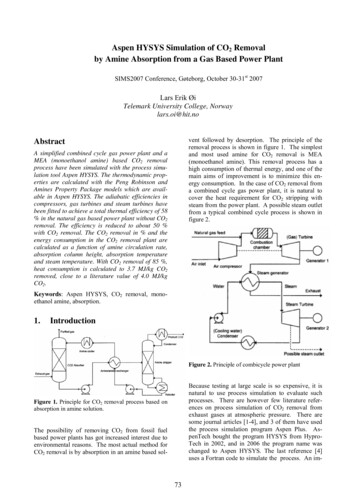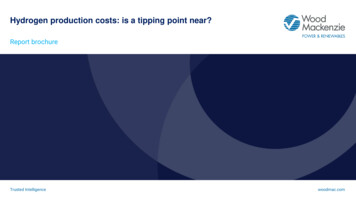
Transcription
Global J. Environ. Sci. Manage. 5(1): 155-166, Winter 2019Global Journal of Environmental Science and Management(GJESM)Homepage: https://www.gjesm.net/ORIGINAL RESEARCH PAPERHydrogen sulfide removal from biogas using chemical absorption technique in packedcolumn reactorsM.B. Kulkarni1*; P.M. Ghanegaonkar2Mechanical Engineering Department, Sinhgad College of Engineering Research Center, Vadgaon, Pune, Maharashtra, India1Keystone School of Engineering, Shewalewadi, Pune, Maharashtra, India2ARTICLE INFOArticle History:Received 25 July 2018Revised 17 October 2018Accepted 19 November 2018Keywords:Biogas purificationChemical absorption techniqueEfficiency calculationsFlow and pressure variationsHydrogen sulfideA B ST R AC TThe toxicity and corrosion potential of hydrogen sulfide in raw biogas underlinesthe need for biogas purification. Several techniques available for removal ofhydrogen sulfide from biogas are out of the reach for common end users dueto lack of knowledge, higher running costs, and insufficient operational skills.The present experimental study aims to propagate hydrogen sulfide removaltechniques amongst the end users by using a low-cost chemical absorptiontechnique and packed column reactors. Commercial grade chemicals likemonoethanolamine, sodium hydroxide, calcium hydroxide, granular activatedcarbon, and steel wool were used for biogas purification in packed columnreactors of 1.2 liters capacity. Hydrogen sulfide removal efficiency up to 92.41%was achievable using single purification columns. The efficiency achieved byusing multiple purification column was up to 96.84%. Hydrogen sulfide removalefficiency was calculated for experimental variants like the use of a dedicatedpurification column, multiple purification columns, flow variations and pressurevariations of raw biogas. The data for the frequency of regeneration/replacementof different chemicals was also determined. The simplicity of operation andthe use of low-cost reagents in the present study can enable the use of thesemethods amongst end users of biogas technology for minimizing health hazardsand corrosion problems.DOI: 10.22034/gjesm.2019.02.02 2019 GJESM. All rights reserved.INTRODUCTIONWidespread use of alternative and renewableenergy sources is necessary to meet the increasingenergy demands of the modern world. Biogas isproduced by the anaerobic digestion of diversified*Corresponding Author:Email: milindkulkarni3210@gmail.comTel.: 918412827863Fax: 912024357243Note: Discussion period for this manuscript open until April 1, 2019on GJESM website at the “Show Article.organic waste materials in the absence of air oroxygen. Production of biogas from waste materialsfulfills the energy needs and also reduces thegreenhouse gas (methane) emission into theatmosphere (Rashed and Torii, 2015). Researchregarding anaerobic digestion mentions its utility asan alternative and efficient fuel technology, whichoffers two-fold benefits like biofuel production andsustainable waste management (Bharathiraja et al.,2018). The operational aspects of the anaerobic
M.B. Kulkarni and P.M. Ghanegaonkardigestion process include feedstock pretreatment,digestion inside the bioreactor, upgrading of thebiogas and the digestate treatment (Monnet,2003). The volume and quality of biogas producedin anaerobic digestion process depend uponparameters like digester temperature, pH of theslurry, retention time, feeding frequency and theuse of catalysts for biogas generation (Sambo etal., 1995); (Mandal and Mandal, 1998). Removalof carbon dioxide and hydrogen sulfide by using anappropriate technique is necessary to improve thebiogas quality and make it suitable for widespreadapplications (Tippayawong and Thanompongchart,2010). Removal of hydrogen sulfide from biogasis highly recommended because of the associatedhealth hazards and also the corrosion of burners,storage tanks, and engine components (Shah andNagarseth, 2015). The origin of hydrogen sulfidein biogas plants refers to the degradation of sulfurcontaining proteins. Removal of hydrogen sulfidecan take place in the digester itself or by usingpurification columns after the digester (Mucheet al., 1985). The permissible levels of hydrogensulfide and the requirement to remove gaseouscomponents from biogas for various applicationsare available from the literature. It is recommendedto remove hydrogen sulfide from biogas for all theapplications like the boiler, kitchen stove, stationaryengines, vehicular applications or injection into thenatural gas grid (Wellinger and Lindberg, 2000).Exposure to hydrogen sulfide (H2S) causes rapidcorrosion and failure of metals. Prolonged exposureto the gas causes serious health hazards in humanbeings. The detrimental effects on health caused byexposure to hydrogen sulfide are mentioned in theliterature (Amosa et al., 2010).Techniques for hydrogen sulfide removal and earlierresearch achievementsVarious techniques are available for removingH2S from biogas. The selection of a techniquedepends upon the sulfur capture efficiency, lowmedia and operating costs, energy prices and socioeconomic policies (Abatzoglou and Boivin, 2009).In a broader perspective, H2S removal techniquescan be categorized as physical-chemical techniqueand the biotechnological technique. The physicalchemical methods are the traditional ones and still156widely used in the market. The biotechnologicaltechniques have found increased applications in thelast two decades and have a higher efficiency thanphysical-chemical methods (Allegue and Hinge,2014). The commonly used H2S removal process canbe classified as the dry oxidation process and liquidphase oxidation process. Biogas desulfurizationtechniques like the introduction of air/oxygen intothe biogas system, adsorption using iron oxide oractivated carbon, liquid phase oxidation using NaOHand FeCl3 are effective for hydrogen sulfide reduction(Kapdi et al., 2005). Using the catalyst iron oxideis a simplified way for hydrogen sulfide removalfrom biogas. Oxidized steel wool or iron chips fromlathe machine are the easily available sources ofiron oxide. Regeneration of iron oxide is possibleby exposing it to the atmospheric oxygen. The wettechnique for hydrogen sulfide removal from biogasuses sodium hydroxide, sodium carbonate, and ironoxide. Various reaction mechanisms for hydrogensulfide removal from biogas and relevant details areavailable from the literature (Shah and Nagarseth,2015). An effective method for reduction of hydrogensulfide comprises the addition of iron chloride, ironoxide or iron hydroxide directly to the digester, oralong with feed substrate in a pre-storage tank. Thismethod is effective for lowering the H2S fraction inbiogas and needs to be operated in combinationwith some another H2S removal method (Allegueand Hinge, 2014). An experimental investigationabout the effectiveness of commercially availablesteel wool for adsorption of hydrogen sulfide (H2S)has been made for duration of sixteen weeks. Rawbiogas is passed through the polyvinyl-chloridecolumns filled with the steel wool. The fixed bed ofregenerated steel wool could eliminate hydrogensulfide with 95% removal efficiency (Magomnangand Villanueva, 2015). The H2S selective absorptionperformance of various oxido-alkaline solutions isfound to be higher than that of amine solutions.Sodium hydroxide (NaOH), monoethanolamine(MEA) and hydrogen peroxide (H2O2) solutionswere used for capturing H2S and CO2 from rawbiogas (Dubosis and Thomas, 2010). Oxidativescrubbing process for selective removal of hydrogensulfide from biogas using an aqueous solution ofsodium hydroxide (NaOH), sodium bicarbonate(NaHCO3) and hydrogen peroxide (H2O2) has been
Global J. Environ. Sci. Manage., 5(1): 155-166, Winter 2019investigated in laboratory scale experiment andthereafter in industrial scale plant. The influenceof pH, redox potential and solution ageing on theabsorption efficiency and the consumption ofchemicals were investigated (Krischan et al., 2012).Methane enrichment of biogas is achieved by usingcalcium oxide, calcium hydroxide, and activatedcarbon. Biogas up-gradation profile depends onthe mass of purification agent, concentration andtime of the purification cycle (Rashed et al., 2016).The concentration of calcium hydroxide solutionand variations in biogas flow rates can affect thehydrogen sulfide removal from biogas (Mel et al.,2014). Biogas purification using chemical absorptionand the reagent sodalime is a cost-effective andeasy-to-use method (Ghatak and Mahanta, 2016).Biogas flow rates, the type of solution used andconcentration of the solution affect the biogaspurification process while using calcium hydroxideand monoethanolamine for biogas purification(Srichat et al., 2017). The removal of hydrogensulfide using chemical absorption is more effectivethan absorption in pure water under similarconditions (Horikawa et al., 2004). Chemicalabsorption technique requires large amount ofthermal energy for solvent regeneration. For thispurpose the concentrating photovoltaic/thermalhybrid system has been integrated with chemicalabsorption technique (Tian et al., 2017). Hydrogensulfide removal efficiency in the range of 85% to 96%is possible using a combined method of absorptionand adsorption. The chemicals used for hydrogensulfide (H2S) removal include iron oxide (Fe2O3),zero valent iron (Feo), and iron chloride (FeCl2)(Rashed and Torii, 2017). Carbon dioxide removalefficiency of 99.98% is observed by using sodiumcarbonate absorbent while 30% efficiency usingwater scrubbing method. Hydrogen sulfide removalefficiency of 70% is obtained by using sponge iron(iron oxide). Algal treatment is used for regenerationof sodium carbonate effluent from the carbondioxide scrubber (Mohanakrishnan and Joseph,2016). Reduction upto 72% in non-combustibleelements of biogas has been achieved using a lowcost, six stage biogas filtration system. The systemcomprises use of water scrubber, silica gel filter, ironsponge filter, sodium hydroxide solution filter, silicagel filter and activated carbon filter for removal ofcarbon dioxide, hydrogen sulfide and moisture frombiogas. The purified biogas has been used to operatealternating current generator with an improvementin operating efficiency (Mojica et al., 2017). Chemicalscrubbing of biogas gives high methane content alongwith reduced hydrogen sulfide content of 102 ppmand 87 ppm during two experimental variants. Steelwool (iron oxide) is used for removal of hydrogensulfide and silica gel for moisture removal from rawbiogas. Sodium hydroxide, calcium hydroxide andpotassium hydroxide are used for carbon dioxideremoval from biogas. The results of road testing of avehicle fueled by purified biogas are also presented(Shah et al., 2016). The present work uses floralwaste as the feedstock for biogas generation. A fewresearch papers are available which state that floralwaste has a good potential for biogas generation(Alkanok et al., 2014); (Ranjitha et al., 2014). Thefloral waste needs to be given drying, mechanicaland alkaline chemical pretreatment for generationof biogas (Singh and Bajpai, 2011); (Singh et al.,2007). In a developing nation like India, there is agreat potential for installation of biogas digestersdue to abundant availability of biomass. In most ofthe domestic or community biogas plants biogaspurification units are not used and the occupantsare prone to health hazards caused by hydrogensulfide. The techniques of biogas desulfurization arestill out of reach for the majority of the common endusers. The factors responsible for this phenomenoninclude unawareness of health hazards of hydrogensulfide, lack of knowledge about biogas purificationtechniques and the cost constraints. The objectiveof present study is to propose low-cost and easyto-use biogas purification techniques for the endusers of biogas technology. The present study hasbeen carried out at Pandharpur, District Solapur,Maharashtra, India in 2018.MATERIALS AND METHODSBiogas is generated from a fixed dome digesterof 6.2 m3 capacity using floral waste with alkalinepretreatment as the feedstock. Raw biogas fromthe digester contains hydrogen sulfide up to 790ppm. Biogas to be purified is passed through thepacked column reactors of 1.2 litres (L) capacityfor removing hydrogen sulfide. The purification157
Hydrogen sulfide removal from biogasFig. 1: Experimental set-up for biogas desulfurizationFig. 1: Experimental set‐up for biogas desulfurizationcolumns are filled with low-cost commercialchemicals like sodium hydroxide, calcium hydroxide,monoethanolamine (MEA), activated carbon andsteel wool (iron sponge). Fig. 1 shows the schematicrepresentation of the set-up used for experimentalwork. The pressure of biogas at the outlet of thedigester is 2.5 cm of mercury or 1.0466 bar (gauge).The pressure of biogas can be increased using acompressor.As shown in Fig. 1, raw biogas from the digesteris first compressed by using a compressor. Thecompressed biogas passes through a U-tubemanometer, where the gauge pressure is measuredin terms of mm of the mercury column. The gasis further passed through a rotameter where thevolume flow rate is measured in L per minute (LPM).For removal of hydrogen sulfide, raw biogas ispassed through single or multiple packed columnscontaining various chemical reagents. The contentsof purified biogas are monitored using a biogasanalyzer. The purified biogas is filled in samplingbags for laboratory analysis. Laboratory analysis ofbiogas is performed by using gas chromatographyin “Nikhil analytical and research laboratory”,Sangli, Maharashtra, India. The laboratory is anISO certified laboratory and approved by thegovernment of India as well as the state governmentof Maharashtra. The packed column reactors havecapacity 1.2 L, out of which aqueous solutions arefilled up to 1 L capacity. The aqueous solutions usedin the experimental investigations include sodiumhydroxide (1.5 Molar), MEA (10% by volume) andcalcium hydroxide (1 Molar). The concentrations ofMEA, NaOH, and Ca(OH)2 were selected based ontheir solubility in water, cost of the chemical andreferences from the literature. Sodium hydroxideand MEA are commercial grade chemicals whilecalcium hydroxide solution is prepared by dissolvingcommercially available limestone in water. Thesolid adsorbents for biogas desulfurization includecommercial grade granular activated carbon andsteel wool (iron sponge) in the form of scrapchips from the lathe machine. The mass of solidadsorbents filled in the purification column is 500 g.All the aqueous solutions and adsorbents have beenselected to minimize the cost of biogas purification.MEA solution after saturation can be regenerated byheating at 120oC while the steel wool adsorbent canbe regenerated by simply exposing to atmosphericoxygen. The efficiency of hydrogen sulfide removaland the chemical cost for biogas purification perm3 of raw biogas are calculated. The variants ofexperimental investigations include determinationof saturation/regeneration time for each of thereagents, calculation of hydrogen sulfide removalefficiency using a single column for each reagent,using multiple purification columns, variations inbiogas flow rate and pressure. A detailed descriptionof different experimental investigations is given inthe following text.Determination of the frequency of regeneration foreach of the reagentsA chemical reagent reacts with carbon dioxideand hydrogen sulfide in biogas and forms reactionproducts. The reagent is thus consumed by thecontaminant gases and saturates after a definitetime. When the reagent in the purification columngets saturated, reduction in hydrogen sulfide contentis not observed at the outlet of purification column.The determination of frequency of regeneration (orreplacement) for a reagent helps to calculate the158
Global J. Environ. Sci. Manage., 5(1): 155-166, Winter 2019volume of biogas purified by unit quantity of thereagent, size of the scrubbing unit and the chemicalcost for biogas purification per unit volume of rawbiogas. The cost of chemical required for purificationof unit volume (1 m3) of biogas is calculated. Forthis purpose, the cost of chemical consumed isdivided by the total volume of gas purified by thereagent before saturation. The cost of chemicalconsumption has a major impact on the total costof biogas purification. The other factors whichcontribute to the total cost of purification includecapital investment and running cost for energyconsumption. The latter factors depend upon thesize of purification unit. Hence the chemical costfor purifying unit volume (1 m3) of biogas has beenpresented in Table 1. In this study, the contents ofraw biogas are initially measured. The raw biogasis passed through the packed column reactorcontaining a known mass/concentration of thepurifying reagent at a flow rate 1 L per min (LPM).The flow rate of raw biogas has been maintainedat 1 LPM to ensure sufficient reaction betweenthe contaminants and the reagent. The pressure ofbiogas at the inlet of purifying column is equal topressure of biogas at the digester outlet, which is 2.5cm of mercury or 1.0466 bar (gauge). The details ofthe frequency of regeneration, the volume of biogaspurified and the chemical cost for purification arerepresented in Table 1.Biogas purification using single purification columnsIn this experiment, hydrogen sulfide removalfrom biogas is achieved by using a dedicated columnfor each of the reagent. Raw biogas is made to flowthrough a single purification column at a flow rateof 2 LPM and a pressure 2.5 cm of mercury. Thepacked column reactors are filled with either 1L aqueous solution or 500 g of the solid adsorbent.The composition of raw biogas and purified biogassamples is measured by using gas chromatography.The contents of purified biogas are noted andcalculations are made for methane rise (%), carbonTable 1: Details of the frequency of regeneration and related data for different reagentsTable 1: Details of the frequency of regeneration and related data for different reagentsSr.No.12345Name of the reagentMonoethanolamine(MEA )Sodium Hydroxide(NaOH*)Calcium Hydroxide#Granular activatedcarbon†Steel wool†(Iron oxide)ChemicalformulaCost of thereagent USConcentration ofaqueous solution ormass of the adsorbentVolume of biogaspurified beforesaturationC2H7NO6.82 per L10% by volume165NaOH1.36 per kg1.5 Molar1780.46Ca(OH)20.2 per kg(lime stone)1 Molar1170.13C5.46 per kg100 g2072.64Fe2O30.2 per kg500 gRegeneration upto 5 timesRegeneration byoxidizationPercent rise or removalConcentration of reagents : 10% by volume, *: 1.5 Molar, #: 1 Molar, †: mass 500 g1009080706050403020100Cost of chemicalfor purification in US/ m3Regeneration byheatingMEA (10 %)NaOH (1.5 M)Activated Carbon (500 g)Steel Wool (500 g)Ca(OH)2 (1 M)Methane Rise (%)Carbon dioxide RemovalEfficiency (%)Hydrogen SulphideRemoval Efficiency (%)Fig. 2: Efficiency for methane rise or carbon dioxide/hydrogen sulfide removal for purified biogasFig. 2: Efficiency for methane rise or carbon dioxide/hydrogen sulfide removal for purified biogas159
M.B. Kulkarni and P.M. Ghanegaonkardioxide removal efficiency (%) and hydrogen sulfideremoval efficiency (%), with reference to thecorresponding content in raw biogas. The resultsfor measurement of biogas contents using gaschromatography are given in Table 2. The efficiencycalculations for each column of the reagent arerepresented graphically in Fig. 2.purification columns contains a different reagent.Biogas flow rates are varied as 2 LPM, 5 LPM and 10LPM, at a constant pressure of 2.5 cm of mercuryor 1.0466 bar (gauge). The efficiencies of hydrogensulfide removal have been calculated for threecombinations of reagents, namely activated carbonand steel wool; sodium hydroxide, activated carbonand steel wool; and calcium hydroxide and steelwool. The results of biogas contents measurementusing gas chromatography are mentioned in Table3. The efficiency calculations for methane rise(%), hydrogen sulfide and carbon dioxide removalBiogas purification using multiple purificationcolumns and variation of biogas flow ratesIn this experimental study raw biogas is passedthrough multiple purification columns. Each of theTable 2: Contents of raw biogas and purified biogas using single purification columnsTable 2: Contents of raw biogas and purified biogas using single purification columnsSr.No.12345ParameterUnitMethaneCarbon dioxideMoistureHydrogensulfideOther 7914.18Chemicals Used for 0.0060.00610.376.5516.53MEA .0088.73Concentration of reagents : 10% by volume, *: 1.5 Molar, #: 1 Molar, †: mass 500 gTable 3: Contents of raw and purified biogas using multiple purification columns and variation in biogas flow ratesTable 3: Contents of raw and purified biogas using multiple purification columns and variation in biogas flow ratesSr.No.Activated carbon† steel wool†NaOH* activatedcarbon† steel wool†Calcium hydroxide# steel 19.3217.439.57ParameterUnit123MethaneCarbon dioxideMoisture4HydrogenSulfide5Other gasesFlow rate of raw biogas Q1: 2 LPM, Q2: 5 LPM, Q3: 10 LPM. Concentration of reagents *: 1.5 Molar, #: 1 Molar, †: mass 500 gTable 4: Contents of raw and purified biogas using multiple purification columns and variation in biogas pressureTable 4: Contents of raw and purified biogas using multiple purification columns and variation in biogas istureHydrogensulfideOther gasesActivated carbon†steel wool†P1P263.5667.76 P360.33NaOH* activated carbon† steel wool†P1P2P361.3674.1463.23Calcium hydroxide# steel 5.022.42250.002511.32UnitGauge pressure of raw biogas P1: 2.5 cm of Hg, P2: 5 cm of Hg, P3: 7.5 cm of Hg.Concentration of reagents *: 1.5 Molar, #: 1 Molar, †: mass 500 g.160
Global J. Environ. Sci. Manage., 5(1): 155-166, Winter 2019efficiency (%) for each combination of the reagentsare represented graphically in Fig. 3.wool; and calcium hydroxide and steel wool. Theresults of biogas contents measurement usinggas chromatography are mentioned in Table 4.The efficiency calculations for methane rise (%),hydrogen sulfide and carbon dioxide removalefficiency (%) for each combination of the reagentsare represented graphically in Fig. 4.Biogas purification using multiple purificationcolumns and variation of biogas pressureIn this experimental study raw biogas is passedthrough multiple purification columns. Each of thepurification columns contains a different reagent.Biogas pressures are varied as 2.5 cm of mercuryor 1.0466 bar (gauge), 5 cm of mercury or 2.0932bar (gauge) and 7.5 cm of mercury or 3.1398bar (gauge) by throttling the compressor outletvalve. The efficiencies of hydrogen sulfide removalhave been calculated for three combinations ofreagents, namely activated carbon and steel wool;sodium hydroxide, activated carbon and steel100Percent rise or removal9080706050403020100RESULTS AND DISCUSSIONSFrequency of regeneration for the reagentsThe results for the frequency of regenerationand the cost of chemical for purifying unit volumeof biogas are represented in Table 1. It is seen thatout of the solid desulfurizing substances, steel woolis a better option due to low-cost and the ability forregeneration. Out of the aqueous solutions, calciumAC SWFlow Rate 2 LPMAC SWFlow Rate 5 LPMAC SWFlow Rate 10 LPMNaOH AC SWFlow Rate 2 LPMNaOH AC SWFlow Rate 5 LPMNaOH AC SWFlow Rate 10 LPMCa(OH)2 SWFlow Rate 2 LPMCa(OH)2 SWMethane Rise (%)Carbon dioxide RemovalHydrogen Sulphide RemovalFlow Rate 5 LPMEfficiency (%)Efficiency (%)Ca(OH)2 SWFlow Rate 10 LPMFig. 4: Biogas purification efficiencies using multiple purification columns at different biogas pressuresFig. 3: Biogas purification efficiencies using multiple purification columns at different biogas flow ratesPercent rise or removal1009080706050403020100Methane Rise (%)Carbon dioxide RemovalEfficiency (%)Hydrogen Sulphide RemovalEfficiency (%)AC SWPressure 2.5 cm of HgAC SWPressure 5 cm of HgAC SWPressure 7.5 cm of HgNaOH AC SWPressure 2.5 cm of HgNaOH AC SWPressure 5 cm of HgNaOH AC SWPressure 7.5 cm of HgCa(OH)2 SW Pressure2.5 cm of HgCa(OH)2 SW Pressure5 cm of HgCa(OH)2 SW Pressure7.5 cm of HgFig. 3: Biogas purification efficiencies using multiple purification columns at different biogas flow ratesFig. 4: Biogas purification efficiencies using multiple purification columns at different biogas pressures161
Hydrogen sulfide removal from biogashydroxide is preferable due to lower cost of chemicaland the ease of availability.represented in Fig. 2.From Fig. 2, it is observed that hydrogen sulfideremoval efficiencies for the reagents MEA, sodiumhydroxide and calcium hydroxide using singlepurification columns are slightly lower (between88.61% and 89.87%). This is due to the fact thatthese chemicals are also effective for removal ofcarbon dioxide from biogas and increasing theheating value. The chemicals calcium hydroxideand sodium hydroxide are cost effective and easilyavailable than MEA. The reagents MEA, sodiumhydroxide and calcium hydroxide can be preferablein the applications where improvement in heatingvalue of biogas is also desired, for example running ofBiogas purification using single purification columnsResults for measurement of biogas contents usinggas chromatography are represented in Table 2.From Table 2 it is seen that all the reagents canreduce hydrogen sulfide in biogas up to or below 90ppm. The reagents activated carbon and steel woolare more effective for hydrogen sulfide removal frombiogas and give minimum hydrogen sulfide contentof 60 ppm in purified biogas. Calculations of variousefficiencies such as methane rise, efficiencies for H2Sand CO2 removal using single purification columns areTable 5: Comparison of results and details of experimental work for the present and previous worksTable 5: Comparison of results and details of experimental work for the present and previous worksResults obtainedDetails of experimental workReferences Hydrogen sulfide (H2S) removal efficiency morethan 95% Regenerated steel wool is as good as new steelwool for H2S removal Steel wool used for H2S removal from biogas Three polyvinyl columns containing steel wool arrangedin seriesMagomnang andVillanueva, 2015 H2S concentration could reach below 50 ppm,which is acceptable for running internalcombustion engines Maximum H2S removal efficiency is 95% Use of zero‐valent iron for H2S removal from biogas H2S concentration in raw biogas between 138‐211 ppmRashed and Torii, 2015 Purified biogas: CO2 between below detectablelevel up to 1.47%. H2S between 8‐12 ppm H2S removal efficiency between 55.55% and70.37% Water scrubber efficiency: 30% Iron oxide for H2S removal CO2 in feed biogas: 4.55 to 5.28%, H2S in feed biogas 27ppm Regeneration of sodium carbonate using algal culture Another run using water scrubbingMohanakrishnan andJoseph, 2016 Purified biogas from first run: 102 ppm H2S or89.65% H2S removal efficiency Purified biogas from second run: H2S 87 ppm or91.18% H2S removal efficiency Raw biogas: methane 61.22%, CO2 32.01%, H2S 986 ppm Iron oxide for H2S removal First run using dry lime and potassium hydroxide for CO2removal Second run using sodium hydroxide and calciumhydroxide for CO2 removalShah et al., 2016 H2S removal efficiency between 85% and 96% Chemicals iron oxide, zero‐valent iron, and iron chloridefor H2S removal Calcium oxide for CO2 removalRashed and Torii, 2017 Raw biogas H2S content: 790 ppm Chemical absorption technique for H2S removal usingpacked columns Reagents for H2S removal (low‐cost, commercial grade):sodium hydroxide, calcium hydroxide,monoethanolamine (MEA), activated carbon and steelwool (iron oxide) Effect of single/multiple purification columns, biogasflow and pressure variations on H2S removal efficiency Biogas generated from floral waste feedstockPresent work H2S removal efficiency between 88.61% to 92.41%using single purification columns H2S removal efficiency between 94.94% to 96.84%using multiple purification columns Biogas flow variations and pressure variationshave a less significant effect on H2S removalefficiency and more significant effect on CO2removal efficiency162
Global J. Environ. Sci. Manage., 5(1): 155-166, Winter 2019reagents steel wool and activated carbon gives thehighest H2S removal efficiency at biogas flow rate of5 LPM and pressure 5 cm of mercury (gauge). Thesecond combination of sodium hydroxide, activatedcarbon and steel wool gives the highest H2S removalefficiency at biogas flow rate of 10 LPM and pressure2.5 cm of mercury (gauge). The combination ofcalcium hydroxide and steel wool gives the highest H2Sremoval efficiency at biogas flow rate of 10 LPM andpressure 7.5 cm of mercury (gauge). The purificationcolumns comprising a combination of sodiumhydroxide, activated carbon and steel wool gives thehighest efficiencies for H2S removal and methaneenrichment. But the operational cost is also high forthis combination. The purification columns comprisinga combination of calcium hydroxide and steel woolgives the minimum operating cost with satisfactoryH2S removal efficiency and methane enrichment. Thefeasibility of operation using multiple purificationcolumns wit
sulfide removal efficiency in the range of 85% to 96% is possible using a combined method of absorption and adsorption. The chemicals used for hydrogen sulfide (H 2 S) removal include iron oxide (Fe 2 O 3), zero valent iron (Feo), and iron chloride (FeCl 2) (Rashed and Torii, 2017). Carbon dioxide removal efficiency of 99.98% is observed by .

